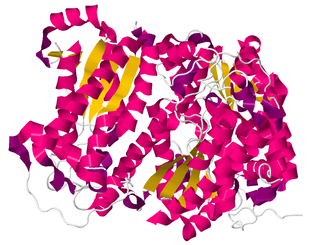| guanidinobutyrase | |||||||||
|---|---|---|---|---|---|---|---|---|---|
| Identifiers | |||||||||
| EC no. | 3.5.3.7 | ||||||||
| CAS no. | 9013-69-8 | ||||||||
| Databases | |||||||||
| IntEnz | IntEnz view | ||||||||
| BRENDA | BRENDA entry | ||||||||
| ExPASy | NiceZyme view | ||||||||
| KEGG | KEGG entry | ||||||||
| MetaCyc | metabolic pathway | ||||||||
| PRIAM | profile | ||||||||
| PDB structures | RCSB PDB PDBe PDBsum | ||||||||
| Gene Ontology | AmiGO / QuickGO | ||||||||
| |||||||||
In enzymology, a guanidinobutyrase (EC 3.5.3.7) is an enzyme that catalyzes the chemical reaction
- 4-guanidinobutanoate + H2O 4-aminobutanoate + urea
Thus, the two substrates of this enzyme are 4-guanidinobutanoate and H2O, whereas its two products are 4-aminobutanoate and urea.
This enzyme belongs to the family of hydrolases, those acting on carbon-nitrogen bonds other than peptide bonds, specifically in linear amidines. The systematic name of this enzyme class is 4-guanidinobutanoate amidinohydrolase. Other names in common use include gamma-guanidobutyrase, 4-guanidinobutyrate amidinobutyrase, gamma-guanidinobutyrate amidinohydrolase, G-Base, GBH, and guanidinobutyrate ureahydrolase. This enzyme participates in urea cycle and metabolism of amino groups. It employs one cofactor, manganese.


